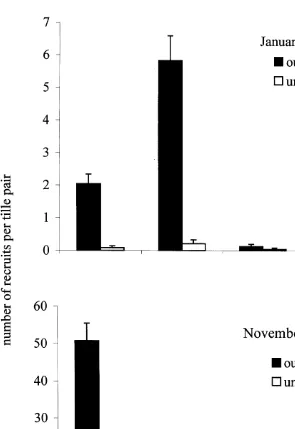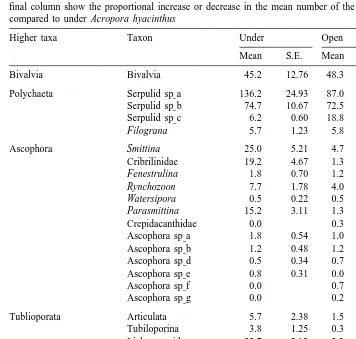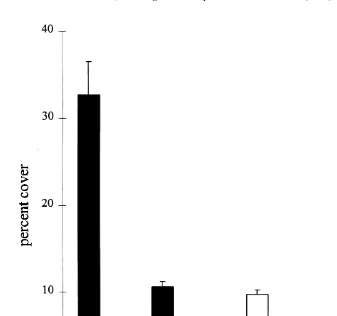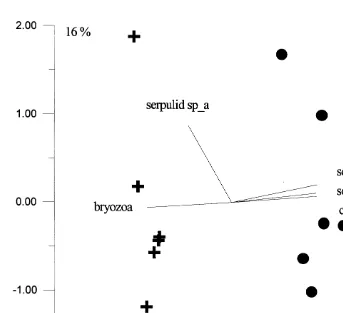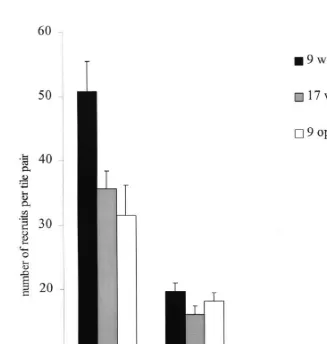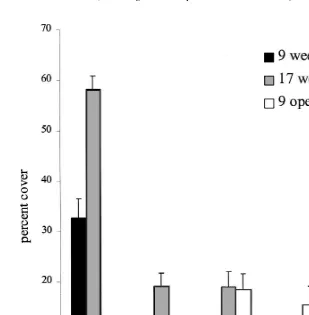251 (2000) 117–132
www.elsevier.nl / locate / jembe
Competitive dominance by tabular corals: an experimental
analysis of recruitment and survival of understorey
assemblages
* A.H. Baird, T.P. Hughes
Department of Marine Biology, James Cook University, Townsville, Queensland 4811, Australia
Received 15 March 1999; received in revised form 28 March 2000; accepted 6 April 2000
Abstract
Tabular and staghorn corals of the genus Acropora often form low-diversity stands on shallow coral reefs, presumably due to their rapid growth rate and ability to outcompete understorey assemblages. Coral cover underneath the abundant Indo-Pacific tabular coral, Acropora
hy-acinthus, was four times lower than on the adjacent substratum on the reef crest at Lizard Island
on the northern Great Barrier Reef. We investigated the effect of A. hyacinthus on patterns of recruitment and mortality by placing experimental panels and coral fragments underneath large colonies of A. hyacinthus. After 8 weeks, recruitment of corals, filamentous algae and crustose coralline algae (CCA) underneath A. hyacinthus was 96, 85 and 50% lower, respectively, compared to panels placed in the open. In contrast, recruitment by bivalves and polychaetes was uniform among treatments, while bryozoans recruited four times more abundantly under A.
hyacinthus than in the open. Consequently, the low rate of recruitment by corals beneath A.
hyacinthus does not appear to be due to a reduction in the delivery of larvae underneath tables.
Instead, the disparity between phototrophic and heterotrophic taxa suggests that diminished light levels under A. hyacinthus are partially responsible for the divergence in recruit assemblages. To test the effect of A. hyacinthus on early mortality and growth of established organisms, recruitment panels were placed on the open for 9 weeks then transplanted underneath A.
hyacinthus for a further 8 weeks. The survivorship of juvenile corals underneath tables was less
than half that of those on control panels on the unshaded reef crest. Furthermore, the abundance of algal turfs and CCA was sharply lower on transplanted panels. In contrast, heterotrophic organisms increased in cover, regardless of treatment. Experimental branch fragments of Acropora
intermedia and Pocillopora damicornis also survived poorly following transplantation underneath A. hyacinthus, compared to adjacent, unshaded controls. We conclude that A. hyacinthus is a formidable competitor which can kill neighbouring corals by overgrowing them, and pre-empt future competition by reducing coral recruitment. 2000 Elsevier Science B.V. All rights reserved.
*Corresponding author. Tel.:161-74-781-4222; fax:161-747-251-570. E-mail address: [email protected] (T.P. Hughes).
Keywords: Competition; Coral reefs; Larval recruitment; Shading; Succession
1. Introduction
Competition for space is an important process affecting the community structure of sessile, benthic assemblages. On coral reefs, competitive interactions are ubiquitous, particularly in shallow water where recruitment and growth rates are high, and where space is often limiting (e.g. Connell, 1976, 1978; Jackson, 1977; Sheppard, 1982). Competition among corals on tropical reefs may be either direct (involving contact and aggression between neighbouring colonies), or indirect. The latter mechanisms include allelopathy and overtopping, where interactions between colonies are mediated through the water column. Areas of substratum beneath overtopping colonies are likely to have reduced ambient light, fewer exogenous food particles, and higher rates of sedi-mentation, all of which are likely to have a deleterious impact on susceptible species (Lang and Chornesky, 1990).
Overtopping may also affect the establishment of potential competitors by inhibiting larval recruitment (e.g. Stimson, 1985; Wallace, 1985a; Fisk and Harriott, 1994). Larval settlement is influenced by reduced light levels since coral larvae exhibit species-specific behavioural responses to the quality and quantity of light (Mundy and Babcock, 1998). Furthermore, the supply of larvae to the substratum under overtopping corals may be altered by changes in the patterns of water movement (e.g. Mullineaux and Garland, 1993), or reduced through presettlement predation by the established corals (e.g. Glynn, 1973). Microfouling communities under overtopping corals may also be altered, depriving corals of necessary cues for settlement (Morse et al., 1988, 1996), while facilitation of coral recruitment by the activities of herbivores may also be reduced (Dart, 1974; Birkeland and Randall, 1982). Early postsettlement mortality is also likely to be affected by overtopping. For example, ‘bulldozing’ by echinoids or snails may increase or decrease, depending on how they aggregate with respect to overstorey corals, while parrotfish grazing is likely to be lower underneath overtopping coral (Sammarco, 1980, Gleason, 1996).
Acropora hyacinthus is a tabular coral which often dominates the reef crest and
physiologi-cal requirements can adapt to different stages in the disturbance regime, analogous to the growth cycle of tropical forests (Whitmore, 1989).
Two studies have closely examined the effect of Acropora hyacinthus on coral assemblages, with conflicting results. Sheppard (1981) compared the coral community under Acropora hyacinthus to that outside the tables, at 10 m depth, on Broadhurst Reef, in the central Great Barrier Reef, but recorded no difference. In contrast, Stimson (1985) examined this pattern at 2–3 m depth on Enewetak Atoll, in the Central Pacific, and showed that the density and diversity of corals was sharply reduced beneath A.
hyacinthus. Acropora hyacinthus may also influence patterns of coral recruitment, although again the existing evidence is contradictory. Wallace (1985a) found that recruitment by corals after 4 months onto experimental plates positioned underneath A.
hyacinthus was four times lower than on adjacent unshaded plates. Moreover, none of
the recruits found under A. hyacinthus were acroporids or pocilloporids, which dominated the unshaded panels. In contrast, Fisk and Harriott (1994) found that recruitment beneath A. hyacinthus after 5 months was reduced much more markedly, recording a 70-fold decline. In contrast to Wallace (1985a), they found a pronounced increase in the relative abundance of pocilloporids on shaded panels. The pre- and post-settlement mechanisms responsible for the reduction in recruitment underneath A.
hyacinthus remain unclear.
In this paper, we conducted a series of experiments to investigate the effects of A.
hyacinthus on its neighbours. To clarify earlier results that have been contradictory
(Sheppard, 1981; Stimson, 1985), we first compare the structure of the coral assemblage underneath Acropora hyacinthus to that in the open to establish the extent of any divergence in these assemblages. We then test the effect of A. hyacinthus on the recruitment patterns of corals, and on the survivorship of coral juveniles and adults. In addition, we examine for the first time the effect of A. hyacinthus on the patterns of recruitment, early survival and growth of other phototrophic and heterotrophic fouling organisms. We hypothesise that all taxa should show some reduction in recruitment underneath A. hyacinthus if reduced water flow causes a lowering in rates of delivery of larvae. Alternatively, reduced light levels would be implicated if the growth and survivorship of phototrophic organisms was disproportionately affected.
2. Materials and methods
sampling of the understorey assemblage enclosed within the chained area. Two circular plots on the reef crest immediately north and south of the sampled colonies of A.
hyacinthus were delimited using the same length of chain. All coral colonies underneath
the A. hyacinthus tables and within the chained areas on the crest were identified to species. For each colony, the maximum diameter and the diameter perpendicular to it were measured to the nearest centimeter. The area of each colony was calculated assuming the colony was an ellipse. The cover of each taxonomic group (see Results) was calculated by summing the areas of each colony and dividing the total by the size of the sampled plots.
2.1. Effects of Acropora hyacinthus on recruitment
To test whether coral recruitment was reduced beneath Acropora hyacinthus, replicate recruitment panels were placed underneath tables and in the open on the reef crest at a depth of 2 m. The panels were deployed for 9 weeks on two separate occasions to examine the influence of A. hyacinthus on two cohorts of coral larvae that differed substantially in taxonomic composition, due to seasonal variation in larval spawning and settlement. The first deployment was from January 8 to March 10, 1994, and was timed to collect pocilloporids which release brooded larvae over an extended period (Tanner, 1996). The second was from November 5, 1994 to January 6, 1995, timed to collect the larvae of broadcast spawning species which spawned at Lizard Island on 22 November, 1994 [L. Vail, personal communication]. The recruitment panels were attached horizon-tally to racks constructed of galvanized wire mesh, approximately 10 cm above the substratum. Pairs of unglazed clay paving tiles (1131131 cm) were bolted either side of the mesh to form a ‘sandwich’, with three tile pairs per rack. Sixteen racks (eight per treatment) were used for the first deployment, and a further ten racks for the second (five per treatment). After retrieval the tiles were bleached to remove soft tissues and 2 filamentous algae, rinsed in fresh water and dried. All surfaces of each tile pair (572 cm per tile pair) were censused for juvenile corals using a stereo dissector microscope at 103 magnification and identified to the family level (Acroporidae, Pocilloporidae, Poritidae, and ‘others’) which is the maximum resolution achievable in coral recruits of this age (e.g. Hughes et al., 1999).
2.2. Effect of Acropora hyacinthus on survivorship of corals and the development of
fouling assemblages
To measure the impact of Acropora hyacinthus on the early survivorship of corals, panels were first seeded with field recruits by placing them on the crest for 9 weeks, after which half were placed underneath tables and the remainder positioned in the open as controls for a further 8 weeks. Ten racks (30 tile pairs) were placed on the reef in November 1994 to collect recruits (at the same time as the second deployment, see above). After 9 weeks, all racks were removed from the substratum and the exterior surface of the bottom tile in each tile pair was photographed. Five of the racks were reattached beneath A. hyacinthus colonies and five were handled identically but returned to the open reef crest. All racks were retrieved 8 weeks later (giving a total deployment duration of 17 weeks), and the tiles were photographed again. The two sets of photographs enabled us to follow the fate of individual recruits over the second (8 week) period. Recruits greater than 1–2 mm were detectable in the photographs. All of these were pocilloporids (as determined from the final census of the bleached tiles) which are larger at settlement and grow faster than other corals (Babcock, 1985; Sato, 1985). In addition to following the survival of individual recruits, we estimated the mortality of the four coral taxa by comparing changes in the mean number of recruits on the bleached tiles in each of the three treatments (9 weeks open, 17 weeks open, 9 weeks open then 8 weeks under A. hyacinthus). The significance of differences in the numbers of corals was tested using one-way ANOVA. To measure the effect of transplantation underneath A. hyacinthus on the development of the fouling assemblage the area cover of the various non-coral taxa was also measured using 50 dots per panel surface, as described above. Percent cover data were log10 (x11) transformed to satisfy the assumption of ANOVA. Differences between the treatments were examined using LSD post-hoc tests.
To test the hypothesis that Acropora hyacinthus influences the survival of adult corals, coral fragments were transplanted underneath tables, and adjacent controls were placed in the open. Sixty fragments, 6–8 cm in length, were generated from two common species; the staghorn Acropora intermedia (formerly A. nobilis) and a small bushy coral, Pocillopora damicornis. Fragments were tied to nails driven into the substratum to prevent movement and abrasion, and half were placed underneath and outside A. hyacinthus. After 8 weeks, all fragments were retrieved and censused as either alive or dead (defined as 100% tissue loss).
3. Results
3.1. Patterns of adult coral abundance
Fig. 1. Mean percentage cover (6S.E.) of eight categories of adult corals on the open reef crest (black bars) and underneath Acropora hyacinthus tables (open bars).
structure. The open, crest assemblage was dominated by Acropora species (32.4%64.8, Fig. 1), which comprised almost half of the total coral cover. Acropora species were six times more abundant in the open than underneath the tables (4.961.3%). Acropora
hyacinthus accounted for over half of the Acropora cover on the crest, but it was not
recorded underneath another table. Mussids (primarily Symphyllia spp.) were virtually absent underneath tables and the abundance of alcyonacean soft corals was eight times lower (Fig. 1). Mound-shaped faviids and encrusting Montipora species were relatively more abundant in the understorey assemblage, but even these taxa showed a 2- to 3-fold decline. Corals underneath A. hyacinthus were often bleached or partially dead, particularly on those parts of the colony that faced inwards away from the growing edge of the A. hyacinthus. Obviously, the lower abundance of corals must be due to a higher rate of mortality and / or a lower rate of recruitment and growth underneath tables (see below).
3.2. Patterns of recruitment
Table 1
Number of coral recruits and the proportion (%) of recruits on upper and lower tiles compared between tiles under Acropora hyacinthus and in the open on each sampling occasion
Treatment Tile Acroporidae Pocilloporidae Poritidae Other Total January– Open Lower 44 (90) 114 (81) 3 (100) 9 (90) 170 (84)
March Upper 5 (10) 26 (19) 0 (0) 1 (10) 32 (16)
Under Lower 1 (50) 0 (0) 0 (0) 0 (0) 1 (11)
Upper 2 (50) 5 (100) 1 (100) 1 (100) 9 (89) November– Open Lower 545 (72) 205 (69) 10 (77) 23 (88) 783 (71)
January Upper 216 (28) 90 (31) 3 (23) 3 (12) 312 (29)
Under Lower 5 (36) 7 (16) 1 (50) 0 (0) 13 (25)
Upper 9 (64) 36 (84) 1 (50) 2 (100) 48 (75)
2). In the first deployment, 68% of all recruits were from the family Pocilloporidae, compared to 29% for the second deployment when the broadcast spawning Acroporidae were much more abundant. In both deployments, the abundance of recruits of all taxa was reduced under A. hyacinthus (Fig. 2). Only ten recruits occurred under tables for the first deployment compared to 202 on the crest, rising to 61 and 1095, respectively, for the second deployment. For the latter, the reduction in the density of pocilloporids under
A. hyacinthus was much less pronounced than for acroporids, resulting in a pronounced 2 difference in the structure of the recruit assemblage among treatments (Fig. 2,x 558.3, df53, P,0.001).
The position of coral recruits on the tile-pairs differed markedly between treatments, due to a shift from the lower tile in the open to the upper, more exposed, tile under
Acropora hyacinthus. For the first deployment, 89% of the coral recruits under A.
hyacinthus were positioned on the top tile compared to only 16% in the open (Table 1).
Similarly, for the second deployment, 75% of recruits under A. hyacinthus were on the top tile compared to only 29% on the crest. This pattern was similar in all coral taxa (Table 1). Note, however, that even though the proportion of coral recruits on the upper tile was always less on the crest, in absolute terms these upper tiles still had more recruits than any tile surface placed underneath the tables (Table 1).
Major differences were evident in the taxonomic composition of the fouling communities that developed on the panels (Table 2). In marked contrast to corals, overall densities of bryozoans were four times higher under Acropora hyacinthus than in the open (Table 2). Ten of the seventeen bryozoan taxa were 2–10 times more abundant under A. hyacinthus, three were equally abundant in both habitats, while only four rare taxa were more abundant outside (Table 2). For all taxa combined, bryozoans covered 9.861.5% of the tiles placed underneath A. hyacinthus after 8 weeks, more than twice that of the panels on the open crest (Fig. 3). In contrast, there was no significant difference in density or area cover of serpulid polychaetes among the two treatments (Table 2; Fig. 3). The density of crustose coralline algae (CCA) was 50% lower under A.
hyacinthus than in the open (Table 2). Similarly, the mean area cover of CCA was one
fifth of that in the open (Fig. 3), indicating that the average recruit was smaller under A.
hyacinthus after 9 weeks. Predictably, the percent cover of filamentous algae was also
Fig. 2. Mean number (6S.E.) of coral recruits on experimental panels placed for 9 weeks on the open reef crest (black bars) and underneath Acropora hyacinthus tables (open bars). Panels were deployed on two sampling occasions; January 1994–March 1994 (top) and November 1994–January 1995 (bottom).
Table 2
Mean number (and 1 S.E.) of various calcareous organisms under Acropora hyacinthus and in the open; the final column show the proportional increase or decrease in the mean number of the taxon in the open when compared to under Acropora hyacinthus
Higher taxa Taxon Under Open Difference
Mean S.E. Mean S.E.
Bivalvia Bivalvia 45.2 12.76 48.3 5.81 0.9
Polychaeta Serpulid sp a] 136.2 24.93 87.0 24.67 1.6 Serpulid sp b] 74.7 10.67 72.5 8.52 1.0 Serpulid sp c] 6.2 0.60 18.8 1.58 0.3
Filograna 5.7 1.23 5.8 1.54 1.0
Ascophora Smittina 25.0 5.21 4.7 0.76 5.4
Cribrilinidae 19.2 4.67 1.3 0.61 14.4
Tublioporata Articulata 5.7 2.38 1.5 0.72 3.8
Tubiloporina 3.8 1.25 0.3 0.21 11.5
Lichenoporidae 32.7 2.12 3.3 1.52 9.8
Anasca Thalamoporella 9.3 1.89 2.5 0.76 3.7
Total polychaeta 222.7 30.46 184.2 30.83 1.2
Total Ascophora 73.7 5.14 17.7 2.44 4.2
Total Tubuliporata 47.5 2.99 8.8 2.52 5.4
Total Anascan 14.3 2.01 3.0 0.58 4.8
Total crustose coraline algae 81.2 7.92 165.0 3.28 0.5
Total bryozoa 135.5 8.14 29.5 3.79 4.6
3.3. Effect of Acropora hyacinthus on survivorship
The rate of mortality of pocilloporid recruits on tiles transplanted under Acropora
hyacinthus was three times higher than on the open crest. After 9 weeks initially on the
Fig. 3. Mean percent cover (6S.E.) of filamentous algae, CCA, bryozoans, bivalves and polychaetes on panels placed for 9 weeks on the open reef crest (black bars) and underneath Acropora hyacinthus tables (open bars).
With the exception of CCA and filamentous algae, the non-scleractinian fouling organisms (bryozoans, polychaetes, bivalves) were not adversely affected by transplanta-tion beneath Acropora hyacinthus. Bryozoans and serpulids increased in area cover on both transplanted and control panels by between 200–400% (Fig. 6), virtually covering them by the end of the study. Bivalves increased in cover twice as fast under the tables than in the open (Fig. 6). In marked contrast, filamentous algae declined by two-thirds after 8 weeks under A. hyacinthus while their coverage on the transplanted controls doubled. The area cover of CCA on panels placed under A. hyacinthus did not change, while the controls also doubled (Fig. 6).
The rate of mortality of transplanted coral fragments was substantially higher under
Acropora hyacinthus after 9 weeks. All 60 fragments (30 each of Acropora intermedia
Fig. 4. Principal components analysis of the assemblages on panels placed for 9 weeks on the open reef crest (circles) and underneath Acropora hyacinthus tables (crosses). Axes 1 and 2 account for 79 and 16% of the variation, respectively. Replicate data point are tile pairs, with six tiles pairs per treatment.
intermedia placed under A. hyacinthus tables died after 9 weeks, and half (15) of the P.
damicornis also succumbed. Moreover, the surviving fragments had lost 40–95% of their tissue, and few, if any, were likely to have remained alive for much longer.
4. Discussion
Fig. 5. Abundance (mean number6S.E.) of recruits of four coral taxa on experimental panels. The panels were first deployed for 9 weeks in the open on the reef crest (represented by the dark bars). The grey bars represent panels that were repositioned on the reef crest for a further 8 weeks (i.e. 17 weeks in total) and the white bars represent panels placed under A. hyacinthus tables (i.e. 9 weeks in the open on the reef crest then 8 weeks under A. hyacinthus). n515 tile pairs in each treatment.
morphology of the A. hyacinthus tables. For instance, Sheppard’s study site was relatively deep (10 m), and the A. hyacinthus colonies there were likely to have been taller and with more open branches than those on the reef crest. Furthermore, Sheppard (1981) recorded a relatively modest reduction in light levels underneath deep A.
hyacinthus (range 5–60% of ambient), compared to a reduction of up to 97% recorded
Fig. 6. Abundance (mean percent cover6S.E.) of filamentous algae, CCA, bryozoans, bivalves and serpulid polychaetes following transplantation under Acropora hyacinthus. The transplanted assemblage (9 weeks in the open on the reef crest) is represented by the dark bars, the grey bars show abundances after a further 8 week in the open (i.e. 17 weeks in total) and the white bars represent the assemblages after a further 8 weeks placed under A. hyacinthus tables (i.e. 9 weeks in the open on the reef crest then 8 weeks under A. hyacinthus). n515 tile pairs in each treatment.
noted a disproportionate decrease in branching Acropora and Pocillopora underneath A.
hyacinthus, but found little difference in other genera of massive and encrusting corals.
In our study, however, all major taxa of corals were reduced underneath tables (Fig. 1). This is likely to be the typical pattern on shallow, semi-exposed reef crests, where A.
hyacinthus forms short colonies with tightly interlocked branches.
The densities of coral recruits in all taxa were significantly reduced beneath Acropora
hyacinthus for both sets of deployments (Fig. 1). Other authors have reported a similar
reduction (Wallace, 1985a; Fisk and Harriott, 1994), although studies differ in the reported effect of A. hyacinthus on the relative abundance of coral recruits. Wallace (1985a) recorded no acroporid or pocilloporid recruits on experimental plates under A.
hyacinthus, even though these two taxa together comprised 93% of recruits on the
eight panels after 4 months), but were even rarer in the open. This pattern led Wallace (1985a) to suggest that these ‘other’ taxa were late successional species which require some modification of the environment to facilitate recruitment. In contrast, Fisk and Harriott (1994) report an increase in the relative abundance of pocilloporid recruits underneath the tables. We also recorded an increase in the relative abundance of pocilloporid recruits, which comprised 68% of the understorey juveniles compared to 34% outside (for both deployments combined, n51368, Table 1). Pocilloporids recruits appear to be relatively unspecialized in their settlement requirements (e.g. Wallace and Bull, 1982; Harriott and Fisk, 1987), whereas acroporids, poritids and ‘other’ taxa do not settle without specific cues (e.g. from CCA, see Morse at al., 1996). Consequently, the reduction in recruitment by acroporids under A. hyacinthus may be, in part, an indirect result of changes in the abundance and taxonomic composition of CCA (Table 2).
While shading by A. hyacinthus is likely to have been the most important factor in reducing recruitment, a number of alternative mechanisms may have been involved. Increased sedimentation might inhibit recruitment under A. hyacinthus if a reduction in water flow caused particles to drop out of suspension and smother juveniles. However, there was no sediment accumulation on tiles placed under A. hyacinthus. In contrast, minor accumulation was evident on the tiles in the open, which nonetheless received substantially more recruits. There is little evidence to suggest a general reduction in the supply of other particles, such as larvae and food, beneath A. hyacinthus. While phototrophic organisms (corals and filamentous algae) showed marked reductions in abundance beneath A. hyacinthus, recruitment by most bryozoan taxa, and some polychaetes was substantially higher under A. hyacinthus (Table 2). In addition, heterotrophic organisms transplanted under A. hyacinthus grew at a similar rate to those in the open; indeed the bivalves grew faster (Fig. 6), which suggests the delivery of food particles was not substantially reduced. It is also unlikely that predation by A. hyacinthus was selective against settling corals, since acroporids capture particles that are generally much smaller than the 0.3–1.5 mm diameter size range of coral larvae (K.R.N. Anthony, personal communication) and corals reject coral larvae when offered them in feeding trials (Lindquist, 1996).
The striking difference in the position of coral recruits between treatments also suggests that light is important (Table 1). All coral taxa exhibited a shift in the location of recruits from the undersurfaces of tiles in the open to the upper tile surfaces underneath Acropora hyacinthus. This pattern could arise from larval preference and / or from differential patterns of mortality. Mortality is likely to be higher on upper tiles in the open where recruits are exposed to sediment and grazing by herbivorous fish. However, Wallace and Bull (1982) placed tiles within cages to exclude herbivores and found that the orientation of recruits (with higher densities on the lower, less exposed tile surfaces) was unchanged compared to uncaged controls. This suggests that the pattern we observed (Table 1) is primarily the result of larval preference for a specific light regime (see Maida et al., 1994; Mundy and Babcock, 1998).
pocilloporids continues for most of the year, compared to a brief annual pulse for most acroporids). Consequently, there was no change in the density of pocilloporids from week 9 to week 17, while the initially high densities of acroporids rapidly declined (Fig. 5). This result implies that the season of deployment and the length of time that panels are submerged will have a profound influence on the relative abundance of recruits.
In conclusion, the Acropora hyacinthus canopy reduces recruitment and the survival of juvenile and adult corals. Other phototrophic organisms, CCA and filamentous algae, also recruit less successfully and grow more slowly underneath tables. Shade produced by the canopy is the most likely cause of these patterns. If the growth of A. hyacinthus continued unimpeded by storms or predators, it is capable of sharply reducing the abundance and diversity of corals in shallow water.
Acknowledgements
We thank the staff at Lizard Island Research Station for their support and Peter Arnold of the Museum of Tropical Queensland for identifying the bryozoans. M. Purdy, V. Hall and S. Watson provided valuable field assistance. The manuscript was improved by comments from A. Bastidas, P. Marshall, L. McCook, K. Michalek-Wagner, J. Wolstenholme and the Coral Ecology Group at JCU. This project was submitted by A.H.B. as partial fulfillment of the requirements for an Honours degree at JCU, and was supported by grants to T.H. from the Australian Research Council. This is contribution number 178 of the Coral Group at JCU. [RW]
References
Babcock, R.C., 1985. Growth and mortality in juvenile corals (Goniastrea, Platygyra and Acropora): the first year. Proc. 5th Int. Coral Reef Symp., Tahiti, Vol. 4, pp. 355–359.
Baird, A.H., Hughes, T.P., 1997. Spatial variation in the recruitment of corals around Lizard Island. Proc. 8th. Int. Coral Reef Symp. Panama, Vol. 2, pp. 1207–1210.
Birkeland, C., Randall, R.H., 1982. Facilitation of coral recruitment by echinoid excavations. Proc. 4th Int. Coral Reef Symp., Manila, Vol. 1, pp. 695–698.
Birkeland, C., Rowley, D., Randall R.H., 1981. Coral recruitment patterns at Guam. Proc. 4th Int. Coral Reef Symp., Manila, Vol. 2, pp. 339–344.
Colgan, M.W., 1987. Coral reef recovery on Guam (Micronesia) after catastrophic predation by Acanthaster planci. Ecology 68, 1592–1605.
Connell, J.H., 1976. Competitive interactions and the species diversity of corals. In: Mackie, G.O. (Ed.), Coelenterate Ecology and Behaviour. Plenum, New York, pp. 51–58.
Connell, J.H., 1978. Diversity in tropical rainforests and coral reefs. Science 199, 1302–1310. Dart, J.K.G., 1974. Echinoids, algal lawn and coral recolonisation. Nature 239, 50–51.
Done, T.J., 1982. Patterns in the distribution of coral communities across the central Great Barrier Reef. Coral Reefs 1, 95–107.
Fisk, D.A., Harriott, V.J., 1994. Are understorey coral communities recruitment limited? Proc. 7th Int. Coral Reef Symp., Guam, Vol. 2, pp. 517–520.
Glynn, P.W., 1973. Ecology of a Caribbean coral reef. The Porites reef-flat biotope: Part II. Plankton community with evidence of depletion. Mar. Biol. 22, 1–22.
Harriott, V.J., Fisk, D.A., 1987. A comparison of settlement plate types for experiments on the recruitment of scleractinian corals. Mar. Ecol. Prog. Ser. 37, 201–208.
Hughes, T.P., Baird, A.H., Dinsdale, E.A., Moltschaniwskyj, N.A., Pratchett, M.S., Tanner, J.E., Willis, B.L., 1999. Patterns of recruitment and abundance of corals along the Great Barrier Reef. Nature 397, 59–63. Hughes, T.P., Connell, J.H., 1999. Multiple stressors on coral reefs: a longterm perspective. Limnol. Oceanogr.
44, 125–133.
Jackson, J.B.C., 1977. Competition on marine hard substrata: the adaptive significance of solitary colonial strategies. Am. Nat. 111, 747–767.
Lang, J.C., Chornesky, E.A., 1990. Competition between scleractinian reef corals — a review of the mechanisms and effects. In: Dubinsky, Z. (Ed.). Ecosystems of the World, Vol. 25. Coral Reefs. Elsevier, Amsterdam, pp. 133–207.
Lindquist, N., 1996. Palatability of invertebrate larvae to corals and sea anemones. Mar. Biol. 126, 745–755. Maida, M., Coll, J.C., Sammarco, P.W., 1994. Shedding new light on scleractinian coral recruitment. J. Exp.
Mar. Biol. Ecol. 180, 189–202.
Morse, A.N.C., Iwao, K., Baba, M., Shimoike, K., Hayashibara, T., Omori, M., 1996. An ancient chemosensory mechanism brings new life to coral reefs. Biol. Bull. 191, 149–154.
Morse, D.E., Hooker, N., Morse, A.N.C., Jenson, R.A., 1988. Control of larval metamorphosis and recruitment in sympatric agaricid corals. J. Exp. Mar. Biol. Ecol. 116, 193–217.
Mullineaux, L.S., Garland, E.D., 1993. Larval recruitment in response to manipulated field flows. Mar. Biol. 116, 667–683.
Mundy, C.N., Babcock, R.C., 1998. Role of light intensity and spectral quality in settlement: Implications for depth-dependent settlement? J. Exp. Mar. Biol. Ecol. 223, 235–255.
Pearson, R.G., 1981. Recovery and colonisatization of coral reefs. Mar. Ecol. Progr. Ser. 4, 105–122. Rogers, C.S., Fitz, III H.C., Gilnak, M., Beets, J., Hardin, J., 1984. Scleractinian coral recruitment patterns at
Salt River Submarine Canyon St. Croix U.S. Virgin Islands. Coral Reefs 3, 69–76.
Sammarco, P.W., 1980. Diadema and its relationship to coral spat mortality: grazing competition and biological disturbance. J. Exp. Mar. Biol. Ecol. 45, 245–271.
Sato, M., 1985. Mortality and growth of juvenile coral Pocillopora damicornis (L.). Coral Reefs 4, 27–33. Sheppard, C.R.C., 1981. Illumination and the coral community beneath tabular Acropora species. Mar. Biol.
64, 53–58.
Sheppard, C.R.C., 1982. Coral populations on reef slopes and their major controls. Mar. Ecol. Progr. Ser. 7, 83–115.
Smith, L., Hughes, T.P., 1999. An experimental assessment of survival, reattachment and fecundity of coral fragments. J. Exp. Mar. Biol. Ecol. 235, 147–164.
Stimson, J., 1985. The effect of shading by the table coral Acropora hyacinthus on understorey corals. Ecology 66, 40–53.
Tanner, J.E., 1996. Seasonality and lunar periodicity in the reproduction of pocilloporid corals. Coral Reefs 15, 59–66.
Veron, J.E.N., Wallace, C.C., 1984. Scleractinia of Australia Vol 4. The Acroporidae. Australian Institute of Marine Science Monograph Series, Angus and Robertson, Sydney.
Wallace, C.C., 1985a. Seasonal peaks and annual fluctuations in recruitment of juvenile scleractinian corals. Mar. Ecol. Progr. Ser. 21, 289–298.
Wallace, C.C., 1985b. Reproduction recruitment and fragmentation in nine sympatric species of the coral genus Acropora. Mar. Biol. 88, 217–233.
Wallace C.C., Bull, G.D., 1982. Patterns of juvenile coral recruitment on a reef front during a spring–summer spawning period. Proc. 4th Int. Coral Reef Symp., Manila, Vol. 2, pp. 345–350.


